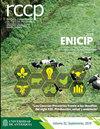绵羊围产期血液学、寄生虫学及生化指标
IF 0.5
4区 农林科学
Q4 AGRICULTURE, DAIRY & ANIMAL SCIENCE
引用次数: 5
摘要
背景:所有动物的怀孕都需要特别的照顾和注意。在此期间,血液学和生化参数有很大的变化。很多时候,这些参数被误解为从未怀孕的动物获得的未知寄生虫状态。目的:了解圣伊内斯羊自然感染围生期血液学、生化及寄生虫学指标。方法:选用平均体重50 kg的母羊45只。在怀孕、分娩和哺乳期间收集数据。测量方法包括体重、体况评分(BCS)、结膜染色评估、血液和粪便收集。结果:所有变量在整个生理阶段均有变化。各组体重和BCS差异有统计学意义(p0.05)。结论:围生期对各项指标的影响值得重视,并可作为参考价值。关于围产期观察到的生理变化,适当的动物管理有助于最大限度地减少寄生虫感染对生产力的负面影响。本文章由计算机程序翻译,如有差异,请以英文原文为准。
Hematological, parasitological and biochemical parameters in sheep during the peripartum period
Background: Pregnancy in all animal species requires special care and attention. During this period there is great variation in hematological and biochemical parameters. Many times these parameters are misinterpreted as being obtained from nonpregnant animals with unknown parasite status. Objective: To characterize the hematological, biochemical, and parasitological values within the peripartum period of Santa Ines sheep naturally infected. Methods: For this purpose, 45 ewes were used, with an average body weight of 50 kg. Data were collected during pregnancy, birth and, lactation. Measurements included body weight, body condition score (BCS), evaluation of conjunctive staining, and collection of blood and feces. Results: All variables changed throughout physiological stages. Weight and BCS were different between periods (p<0.05). Fecal egg counts (FEC) were higher in the peripartum period, with a predominance of Haemonchus ssp, 92.85%. Mean hematological and biochemical values varied throughout the study, (p>0.05). Conclusion: The influence of peripartum on the parameters studied should be considered and its use as a reference value. Regarding the physiological variations observed during peripartum, proper animal management could help minimizing the negative effects of parasitic infections on productivity.
求助全文
通过发布文献求助,成功后即可免费获取论文全文。
去求助
来源期刊

Revista Colombiana De Ciencias Pecuarias
AGRICULTURE, DAIRY & ANIMAL SCIENCE-
CiteScore
0.80
自引率
0.00%
发文量
18
审稿时长
6-12 weeks
期刊介绍:
The editors of Revista Colombiana de Ciencias Pecuarias (RCCP) welcome the submission of original manuscripts on experimental and clinical studies associated with the broad areas of animal sciences and veterinary medicine as they interface with biochemistry, molecular biology, physiology, pharmacology, toxicology, pathology, microbiology, parasitology, immunology and epidemiology. The scope of the journal includes studies of basic and applied research in animal management and production, feeding and nutrition, reproduction, breeding, genetics, animal welfare and behavior; as well as animal production focussed from biotechnology, soil science, agrostology, silvopastoral systems, livestock economics and the environment.
The criteria for acceptance of papers submitted for publication are originality, quality and clarity of the content. Each contribution must be based on original, unpublished research that has not been simultaneously submitted to other journals. All papers will be peer reviewed. All authors bear responsibility for ensuring the integrity and quality of their reported research. It is the author''s responsibility to secure permission to use figures or tables that have been published elsewhere.
Contributions may be classified as original research, review, rapid communication, clinical case studies or methodological articles, as well as news/commentaries or letters to the editor. Most review articles are invited by the editor. Authors interested in submitting a review article should contact the corresponding editor. Rapid publication of original manuscripts is a goal of the journal. Manuscripts must be written in English. Each manuscript is considered for publication with the understanding that it has not been simultaneously submitted to any other journal. Upon acceptance for publication, papers are subject to editorial review and revision.
 求助内容:
求助内容: 应助结果提醒方式:
应助结果提醒方式:


